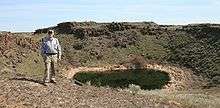Kolk

A kolk (colc) is an underwater vortex created when rapidly rushing water passes an underwater obstacle in boundary areas of high shear. High velocity gradients produce a violently rotating column of water, similar to a tornado. Kolks can pluck multi-ton blocks of rock and transport them in suspension for thousands of metres. [1][2]
Kolks leave clear evidence in the form of plucked-bedrock pits, called rock-cut basins or kolk lakes and downstream deposits of gravel-supported blocks that show percussion but no rounding.[1]
Examples

Kolks were first identified by the Dutch, who observed kolks hoist several ton blocks of riprap from dikes and transport them away suspended above the bottom.[1]
Kolks are credited with creating the pothole-type geographical features in the highly jointed basalts in the channeled scablands of the Columbia Basin region in eastern Washington. Depressions were scoured out within the scablands that resemble virtually circular steep-sided potholes.[2] Examples from the Missoula Floods in this area include:[1]
- The region below Dry Falls includes a number of lakes scoured out by kolks.
- Sprague Lake is a kolk-formed basin created by a flow estimated to be 8 miles wide and 200 feet deep.
- The Alberton Narrows on the Clark Fork River shows evidence that kolks plucked boulders from the canyon and deposited them in a rock and gravel bar immediately downstream of the canyon.
- The south wall of Hellgate Canyon in Montana shows the rough plucked surface characteristic of kolk-eroded rock.
- Both the walls of the Wallula Gap and the Columbia River Gorge also show the rough plucked surfaces characteristic of kolk-eroded rock.
- Oswego Lake, in the middle of Lake Oswego, Oregon (a Portland suburb), was an abandoned channel of the Tualatin River that was scoured by a kolk
- The Larrelt Kolk near Emden appeared during the 1717 Christmas flood which broke through a long section of the dyke. The newly formed waterbody measured roughly 500 × 100 m and was 25 m deep. In spite of the repair to the dyke, there was another breach in 1721, which produced more kolks between 15 and 18 m deep. In 1825 during the February flood near Emden a kolk of 31 m depth was created. The soil was saturated from here for a further 5 km inland.